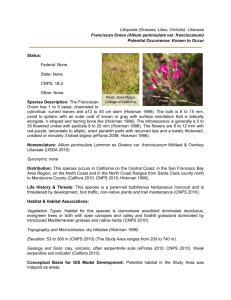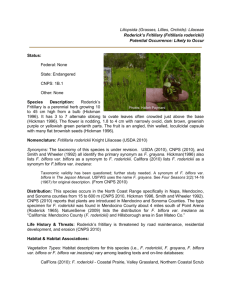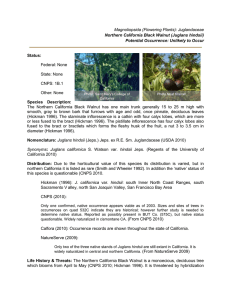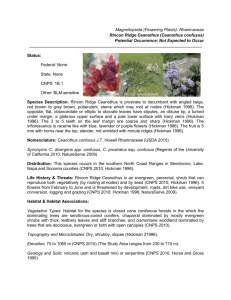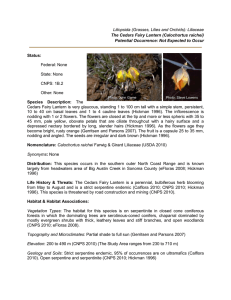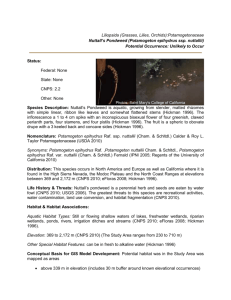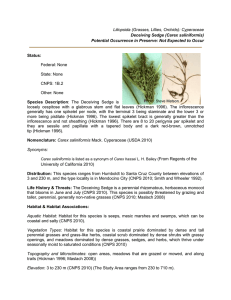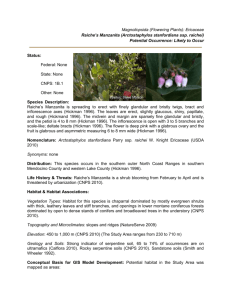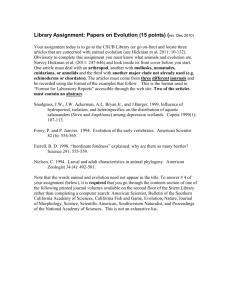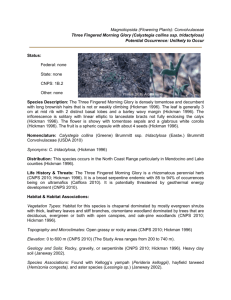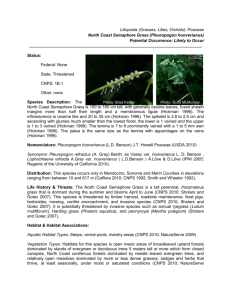PICA Text
advertisement
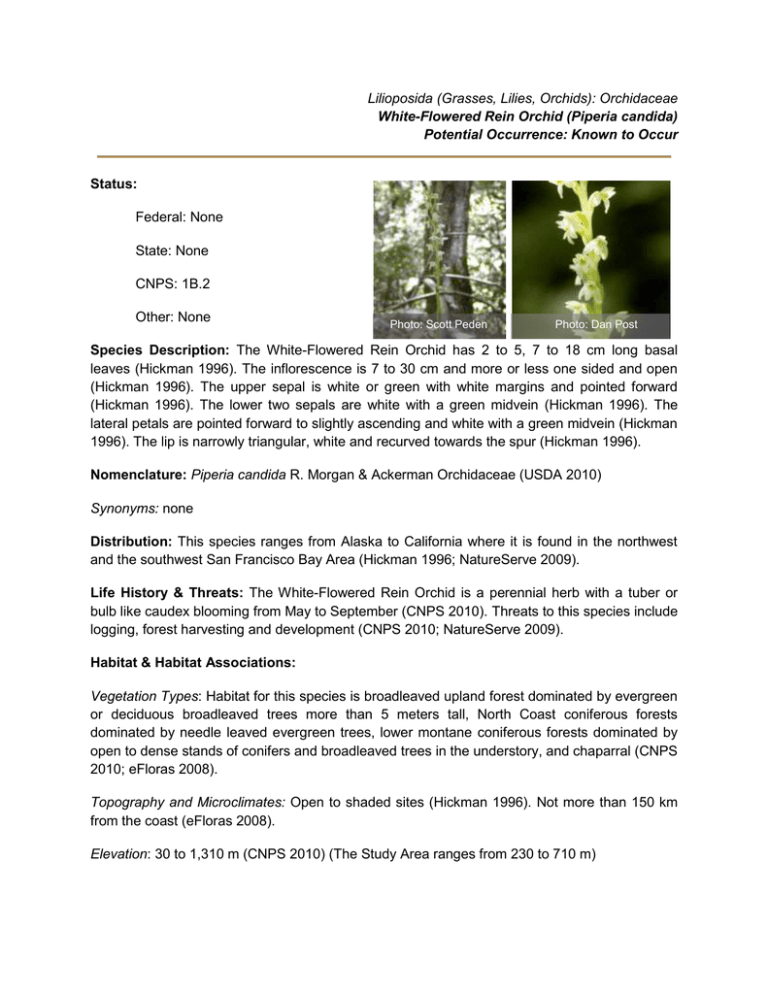
Lilioposida (Grasses, Lilies, Orchids): Orchidaceae White-Flowered Rein Orchid (Piperia candida) Potential Occurrence: Known to Occur Status: Federal: None State: None CNPS: 1B.2 Other: None Photo: Scott Peden Photo: Dan Post Species Description: The White-Flowered Rein Orchid has 2 to 5, 7 to 18 cm long basal leaves (Hickman 1996). The inflorescence is 7 to 30 cm and more or less one sided and open (Hickman 1996). The upper sepal is white or green with white margins and pointed forward (Hickman 1996). The lower two sepals are white with a green midvein (Hickman 1996). The lateral petals are pointed forward to slightly ascending and white with a green midvein (Hickman 1996). The lip is narrowly triangular, white and recurved towards the spur (Hickman 1996). Nomenclature: Piperia candida R. Morgan & Ackerman Orchidaceae (USDA 2010) Synonyms: none Distribution: This species ranges from Alaska to California where it is found in the northwest and the southwest San Francisco Bay Area (Hickman 1996; NatureServe 2009). Life History & Threats: The White-Flowered Rein Orchid is a perennial herb with a tuber or bulb like caudex blooming from May to September (CNPS 2010). Threats to this species include logging, forest harvesting and development (CNPS 2010; NatureServe 2009). Habitat & Habitat Associations: Vegetation Types: Habitat for this species is broadleaved upland forest dominated by evergreen or deciduous broadleaved trees more than 5 meters tall, North Coast coniferous forests dominated by needle leaved evergreen trees, lower montane coniferous forests dominated by open to dense stands of conifers and broadleaved trees in the understory, and chaparral (CNPS 2010; eFloras 2008). Topography and Microclimates: Open to shaded sites (Hickman 1996). Not more than 150 km from the coast (eFloras 2008). Elevation: 30 to 1,310 m (CNPS 2010) (The Study Area ranges from 230 to 710 m) Geology and Soils: Sometimes serpentinite (CNPS 2010). This species is a week indicator of serpentine soil (Calflora 2010). Conceptual Basis for GIS Model Development: Potential habitat in the Study Area was mapped as: Broadleaved upland forests (i.e. mixed, mixed montane or single dominant hardwoods with canopy cover > 40%) North coast coniferous forests (i.e. Redwood-Douglas fir mix (Sequoia sempervirensPseudotsuga menziesii) and Pacific Douglas fir (Pseudotsuga menziesii var.menziesii) vegetation types with a canopy cover of > 40%) Chaparral (i.e. Northern mixed chaparral or scrub oak) Potential Occurrence in the Galbreath Wildlands Preserve: Habitat: White-Flowered Rein Orchid occurs in chaparral, and shaded broadleaved and coniferous forests. Chaparral does not occur within Preserve boundaries, but the shaded woodlands and forests required by this species are abundant (Figure 12). Habitat quality is likely only moderate. This species is known to be negatively impacted by forestry practices and the Preserve has a long history of logging which was only discontinued in 2000. Timber harvest plans indicate that both clear cut and selection cut methods were used to harvest Redwood, Douglas Fir, and hardwoods at least as far back as 1988. This may have compromised the quality of habitat for White-Flowered Rein Orchids. Nearest Occurrence: Documented Occurrences in the Galbreath Wildlands Preserve: White-flowered rain orchid was found at 12 roadside sites (300 individuals) in northern areas of the Preserve in 2013 (Geri Hulse-Stevens, Kerry Heise, Patty Madigan, Janet Olave pers. comm; location and abundance data available from SSU Preserve staff). Note that these data are not shown on the attached map. Nearest Occurrence to the Galbreath Wildlands Preserve: This species is documented in areas to the north and south of the Preserve and is known from 16 occurrences in Mendocino County (Calflora 2010). The nearest occurrence is approximately 16 miles north of the Galbreath Wildlands Preserve in the Navarro River watershed (Calflora 2010). Occurrence of this species on the Preserve would not be a range extension from known distributional records (Calflora 2010). Summary: The White-flowed Rein Orchid is “Known to Occur” on the Preserve. References Calflora. 2010. Information on California plants for education, research and conservation.<http://www.calflora.org/>. Accessed 2010 Jul 2. California Native Plant Society (CNPS). 2010. Inventory of Rare and Endangered Plants. Online edition, v7-10b. <http://www.cnps.org/inventory>. Accessed 2010 Jul 2. Hickman JC editor. 1996. The Jepson Manual Higher Plants of California. 3rd printing. London: University of California Press, Ltd. 1215 p. eFloras 2008. Flora of North American. Published on the Internet <http://www.efloras.org>. Accessed 2010 Jul 2. NatureServe. 2009. NatureServe Explorer: An online encyclopedia of life [web application]. Version 7.1. <http://www.natureserve.org/explorer>. Accessed 2010 Jul 2. Peden S. 2002. Piperia candida Peral Orchid. < http://calphotos.berkeley.edu/cgibin/img_query?rel-taxon=contains&where-taxon=Piperia+candida>. Accessed 2011 Apr 25. Post D. 1986. Piperia candida White-flowered Rein Orchid. < http://calphotos.berkeley.edu/cgibin/img_query?rel-taxon=contains&where-taxon=Piperia+candida>. Accessed 2011 Apr 25. SSU Field Stations and Nature Preserves. 2010. Galbreath Wildlands Preserve Vascular Plant List. <http://www.sonoma.edu/preserves/docs/galbreath_vascular_plants.pdf>. Accessed 2010 Jun. United States Department of Agriculture (USDA). 2010. PLANTS Profile. <http://plants.usda.gov/java/nameSearch?mode=symbol&keywordquery=PICA13>. Accessed 2010 Jul 20. Species Account Description: Linden Schneider
